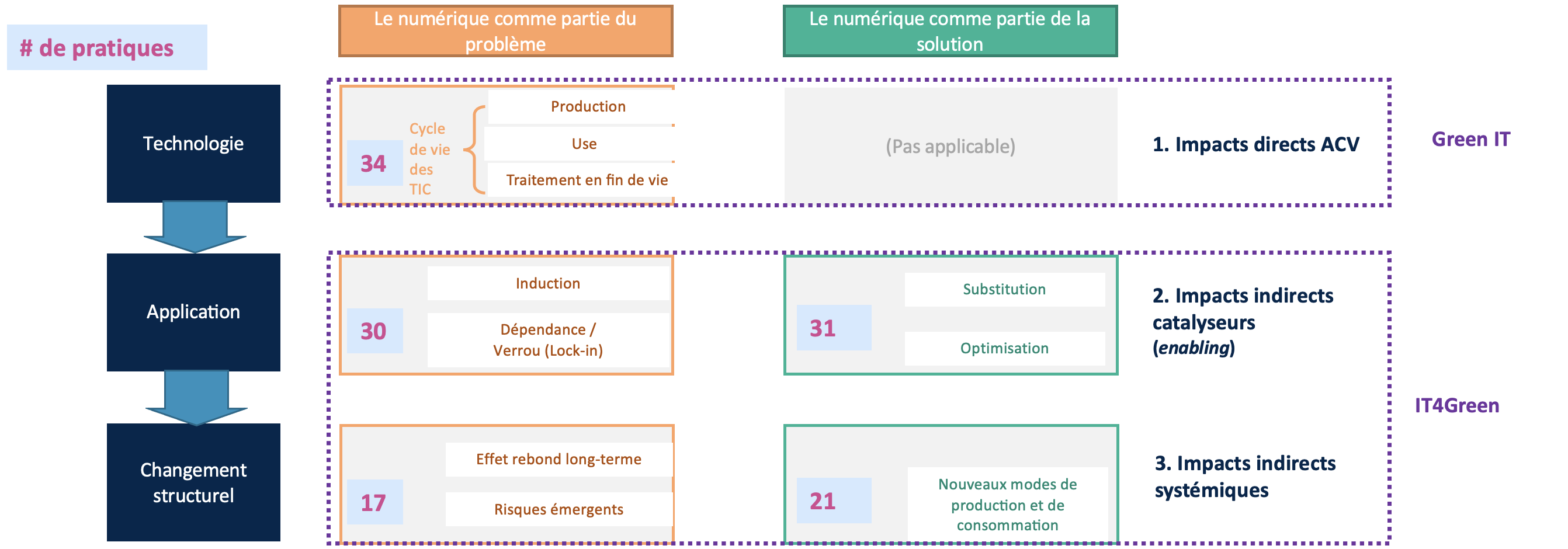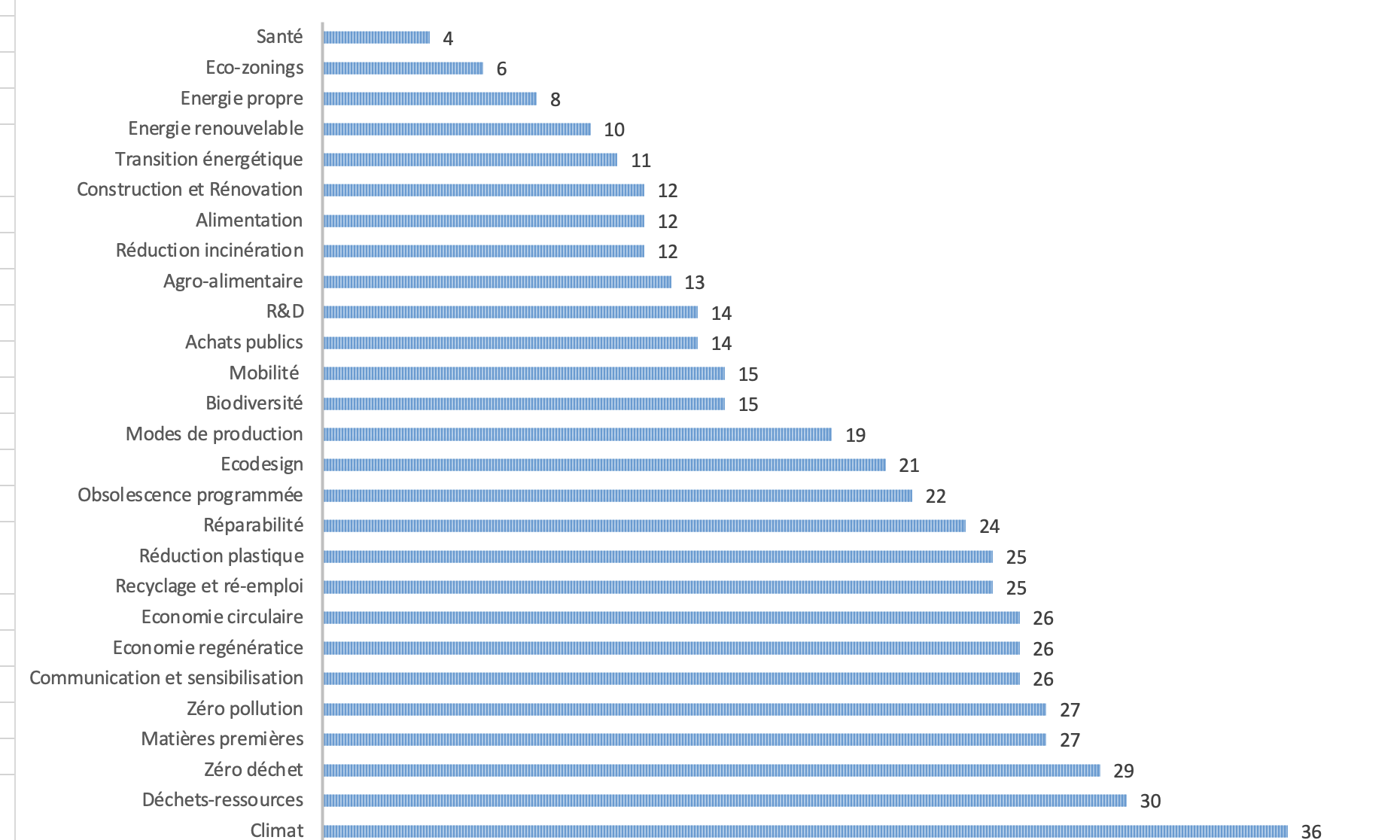
Digital study and environment (3/7). International inspiration
Published on 11 March 2022
Publication
The European Commission and several countries are launching Green IT and IT 4 Green actions. The AdN study lists 45 inspiring best practices for Wallonia. They cover e-waste management, the fight against programmed obsolescence, innovation in the service of the environment, support for sustainable consumption patterns and the role of open data in the ecological transition.
The Digital Agency has been commissioned by the French Minister for the Economy and the Digital Economy to carry out in 2021 a study on the environmental and climatic impact of digital tools with a view to making recommendations, as part of Digital Wallonia.
This dossier is divided into several articles presenting the different parts of the study:
Digital study and environment (2/7). A practical guide to successful transformation
Etude numérique et environnement (3/7). L’international pour inspiration
Digital study and environment (4/7). Perceptions and expectations of Walloon players
Digital study and environment (5/7). Areas of action for Wallonia
Etude numérique et environnement (6/7). Une dynamique wallonne en marche [FR]
Digital study and environment (7/7). Methodological framework and sources
45 inspiring international best practices
With the aim of inspiring the Walloon government and its Minister for the Economy and Digital Affairs, the Digital and Environment study identifies 45 international best practices. These refer to publications, policies, roadmaps and laws that define ambitions for reducing the environmental impact of digital technology, or use it as a lever in specific sectors.
The 45 practices selected meet the following criteria:
they have already been implemented in specific regions or countries.
they have a real positive impact on the environment. It's not a question of exhibiting micro-practices developed on a citizen or neighborhood scale.
they must be relevant to the Walloon context and replicable.
they have been described at an institutional level, and are therefore inspiring for a government like ours. Moreover, 84% of them are implemented at national level, and the remaining 16% at supranational level.
In order to draw inspiration from the international scene, the best practices focus on practices developed mainly by the European Commission, European governments and countries bordering Belgium. With a view to capturing the best government innovations in this field, the focus is also on practices in the governments of Nordic countries, such as Denmark and Finland, and English-speaking countries, such as the UK and Canada.

Priority to Green IT
The best practices selected target various players. The majority, i.e. 40%, target public authorities, 31% society in general and 29% businesses. They adopt different digital approaches. 40% of them are defining actions within the framework of a Green IT approach, and 29% are moving towards IT 4 Green. 31% of best practices include both approaches in a more integrative logic.
This international benchmark shows that governments around the world are giving priority to Green IT, and therefore to reducing the environmental footprint of digital technology.

A comprehensive approach to digital technology
At institutional level, and based on this international benchmark, 78% of the actions implemented aim to address the relationship between digital technology and the environment in a comprehensive way. This means that no technology is precisely targeted to reduce its impact or use it as a lever to support the environmental transition.
The remaining 22%, meanwhile, expose actions that target very specific technologies such as IoT, Blockchain, AI, cloud or digital twins.
Priority to climate protection and waste management
At present, the practices implemented by international governments in terms of digital technology and the environment are geared towards very specific issues such as climate protection, optimized waste management and use of raw materials, the circular and regenerative economy, recycling, plastics and extending the life of equipment. These international priorities are in line with the main thrusts of Wallonia's strategies.
They also demonstrate the full potential of digital technology in accelerating sustainable transition. The best practices identified can, in time, all be transposed to Wallonia. However, almost 75% of them require prerequisites to ensure the success of these actions (mobilization of stakeholders, modification of consumption and production patterns, existence of a dynamic of innovation and entrepreneurship, etc.).

The Digital & Environment study encompasses a total of 520 examples categorized under 45 concrete best practices implemented by international governments. Five examples are developed below.
Supporting and strengthening the WEEE reuse, reconditioning and repair sectors
The European Commission encourages :
The construction and display of a "reparability" and durability index for all digital equipment and services marketed in Europe.e.
Support the repair of digital equipment and the reuse of electronic materials and components.
Mandatory display of sustainability, repairability and environmental footprint criteria for digital products on online platforms and marketplaces in Europe.
To this end, it extends the framework for setting eco-design requirements for energy products to the digital sector, and entrusts the Joint Research Center and the European Committee for Standardization in Electronics and Electrotechnology with this task.
Thanks to these actions, it aims to achieve a European remanufacturing market valued at over 100 million euros by 2030, with the added bonus of reducing CO2 emissions by 21 megatons and creating half a million jobs.
At national government level, the UK and France have amended their legislation to encourage the reconditioning and reuse of digital equipment. By way of example, from 2024 France will require all producers in the digital sector to communicate to any customer or reseller who requests it the "repairability" index of equipment sold, as well as the criteria used to calculate it. Since 2021, France has made available to its population a repair fund dedicated to the fight against waste and the circular economy..
The latter covers part of the cost of repairing digital equipment. Finally, France has drawn up a strategy to reduce the carbon footprint of public sector digital technology, which includes policies for purchasing re-conditioned equipment and eco-gesture training for public sector employees, in order to bring about a change in usage patterns.
This best practice requires the following prerequisites:
The development of solid regional and European expertise in the reuse, reconditioning and repair of WEEE (electrical and electronic waste).
Raising users' awareness of the need to use second-hand equipment.
Combating programmed obsolescence, including software and indirect obsolescence
At European level, the European Commission is currently working with industry to set robustness criteria for digital equipment by category. Its work also includes establishing a suitable legal vehicle for the inclusion of legislative provisions relating to the right to repair and the fight against software obsolescence as part of its circular economy plan.
The French government is planning to introduce a Europe-wide ban on the programmed obsolescence of French digital equipment. Among other things, this solves the problem of proving the existence of a technique designed to deliberately shorten the lifespan of equipment. This action is in line with the government's intention to sanction "intentional irreparability", and its extension to software and indirect obsolescence.
In the same vein, the government intends to oblige software publishers to obtain users' consent before downloading updates, and to specify each time the volume involved, its purpose and whether it concerns evolutionary or corrective updates. It also intends to impose the reversibility of software upgrades to an earlier version for a certain period of time.
As part of the European directive on eco-design and repair of electrical and electronic equipment, the German government is introducing binding regulations for the supply of updates, repair instructions and spare parts to the B2B and B2C markets. The regulations concern batteries, displays and other short-life hardware components.
This best practice requires the following prerequisites:
Be able to demonstrate, on a regional scale, the desire to reduce the lifespan of digital equipment or software;
Raise users' awareness of the psychological obsolescence stimulated by advertising and fashion.
Putting digital innovation to work to preserve the environment and biodiversity
In 2020, the European Commission launched a european center for biodiversity whose mission is to understand and monitor changes in biodiversity using digital technology. The center works closely with the European Environment Agency and the various member state governments.
Another initiative envisaged by the European Commission is linked to the European Data Strategy. In this case, the Commission is setting out the establishment of a common European data space for the Green Deal. This common space aims to better exploit data to reinforce the various actions around climate change, the circular economy, zero pollution, biodiversity, deforestation and ensuring compliance with legislation.
At state level, the German government, following on from the European Biodiversity Centre, set up a national biodiversity monitoring center in 2020. The latter analyzes climatic parameters in Germany using digital tools, and more specifically, the application of environmental law through the analysis of satellite data, sensors and automated analysis methods.
The government has also set up sustainable digital agriculture laboratories to test new, digitally-based agricultural models. Finally, it has set up a series of information systems to manage and improve the management of water and distribution infrastructures.
The French government has set up a program of innovation and experimentation in favor of civic tech in the development and implementation of ecological transition strategies. Hosted projects, such as those dedicated to the analysis of biodiversity erosion phenomena, involve a wide range of players including companies, startups, citizen-experts, ministries, public establishments and local authorities.
France is also investing in projects aimed at using :
digital technology to develop agricultural models based on the activation of natural ecosystems throughout the agri-food chain.
probes and sensors for real-time management of water networks.
and process data to promote sustainable fishing.
satellite photographs of large forest areas to locate illegal deforestation activities.
connected sensors, drones and social networks to understand the impact of human activity on natural ecosystems.
Supporting more responsible digital consumption
The European Commission supports the introduction of digital product passports in its member states, especially for digital products. Among other things, this ensures better traceability of the materials and ores used during the design and production phases.
The ultimate aim of these passports is to limit international dependence on the materials used, by finding new alternative solutions.
They also support the dissemination of existing fair trade eco-labels, by incorporating the working conditions of the workers, sometimes miners and/or in conflict zones, who extract the minerals needed for our digital consumption.
The issue of mineral traceability is extremely complex and no manufacturer is currently able to trace them 100%.%. Product passports are part of the implementation of the single market for green products, which aims to facilitate information on the environmental performance and footprint of products throughout their life cycle. Finally, product passports play a central role in the development of more responsible consumption and purchasing patterns.
They provide an overview of the complete life cycle, enabling consumers, industry and the management of electrical and electronic waste to act more responsibly. At member state government level, Germany intends to promote passports for digital products during its presidency of the EU Council, and Denmark has introduced standardized passports for products, including digital ones, and buildings as part of its circular economy strategy.
To discourage over-consumption of digital terminals, the European Commission is proposing to tax the negative externalities associated with terminal manufacture by introducing a carbon tax at European borders. The latter is a first lever for reducing the environmental footprint of digital technology, as it makes purchasing more expensive and reduces the attractiveness of models supplied outside the EU zone.
At the same time, it makes terminals from reconditioning and repair activities more attractive.
With a view to reducing the carbon footprint of the production phase, in 2021 the European Union signed Regulation 2017/821 laying down due diligence obligations for the supply chain of tin, tantalum, tungsten and rare minerals from conflict or high-risk areas. This action supports a more respectful choice of the materials needed in the production phases of electrical and electronic components. It is also mentioned in the European Union action plan for the circular economy.
At European government level, France's circular economy and anti-waste strategy includes a program to educate and raise awareness of waste reduction, reuse and recycling of products and materials, and sorting of products, including digital products. In a similar vein, the UK has set up a free, autonomous education program on the subject of the sustainability of technology and the continuous improvement of its use.
Finland, for its part, has stepped up its efforts to educate users about the environmental impact of digital technology, encouraging them to adopt more respectful purchasing and usage habits.
Putting data at the service of the environment and the governance of the ecological transition
The European Commission has launched the 2021 B2G data sharing, which is a data law that encourages the development of common European data spaces in certain strategic sectors or areas of public interest.
It also launched the GreenData4All which evaluates and revises the Directive establishing an Infrastructure for Spatial Information in the European Union (INSPIRE Directive), as well as the Directive on Access to Environmental Information.
Open data initiatives can be observed at the level of European governments. Denmark shares common data on topography, climate and water in different sectors to support good governance during extreme events. It is also using data to improve governance on energy management issues via pilot projects in buildings.
In France, the government intends to generalize the notion of data of general interest to environmental data, particularly in key sectors of the ecological transition such as energy, the circular economy, waste treatment, pesticide use, etc.
The sovereignty of free data, produced or financed by the state and local authorities, aims to encourage its processing and analysis to enhance environmental protection. To this end, France is launching a hub on environmental data to ensure data control on a regional scale and involve private players and citizens in the process.
Other European countries have set up open data initiatives for the benefit of the environment. For example, the German government has created an open source platform for open data on the protection of natural resources. This platform feeds research projects and gives all users access to raw data on the environmental situation in Germany.
The Danish government, for its part, has integrated open data into the public sector and organizes hackathons to stimulate an entrepreneurial and innovative environment around the use of data to benefit climate and biodiversity.
To learn more
About the author

Djida Bounazef
